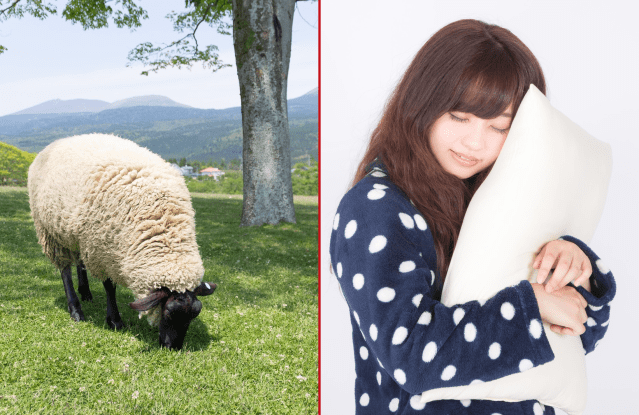
Japanese children’s book suggests we might have been doing it wrong all this time.
It’s a cliché seen everywhere from classical literature to Saturday morning cartoons; the concept of counting sheep in your head to fall asleep. It’s even well-known in Japan.
However, in the real world it never seemed to make much sense, and in 2002 a study at Oxford University declared that envisioning a line of fluffy animals jumping over a fence actually delayed going to sleep.
Although flying in the face of a time-tested tactic, it’s hard to argue with science, especially from Oxford. So, the concept was virtually dead in the water and dismissed as ancient hogwash, until along came a Japanese animal trivia book for kids that raises interesting questions that may blow the whole thing wide open again.
きょうは #とんちの日 #クイズの日 。
— 世界文化社の本【公式】 (@sebunmedia) January 9, 2019
味覚にないのは塩味と辛味どっち??なぜ犬にはポチという名前が多いの??など動物、自然、社会など身の回りの疑問をおもしろく、わかりやすく解説!
『子どもに大ウケ たのしい雑学クイズ365』https://t.co/AOPQyIvm5n pic.twitter.com/GNosllOgdb
The book, Kodomo ni Daiuke Tanoshi Zatsugaku Quiz 365 (365 Super Fun Trivia Quiz for Kids), tackles counting sheep as it relates to Japanese people, and rather than agree with or dispute the findings out of Oxford, they look at it from a whole new perspective.
According to author Tomohiko Nakamura, the reason that counting sheep doesn’t work in Japan is because of the differences in the words for “sheep.” One of the big differences between spoken English and Japanese is that English tends to be much more breathy with its consonant sounds.
▼ This difference is often brought up in the NHK English-learning kids’ program Eigo de Asobo featuring Atsugiri Jason. As you can see, the kids love it.
In particular, the English “sh” sound requires a forceful exhale of air against the back of the teeth. When done repeatedly it won’t be long until you’ll need to take a deep breath in order to continue doing so.
Compare this to the Japanese word for sheep “hitsuji.” Personally, without that breathy “sh” I can easily tally off twice as many hitsuji (even with the “biki” counter) before needing to refill my lungs than I can with the word “sheep.”
So in conclusion, Nakamura says that Japanese people can’t use the same animal to kick-start that deep breathing. This also indirectly suggests that the real reason to count sheep isn’t to envision them as a mental exercise, but to actually say the words as a physical exercise to promote steady deep breaths.
The reason the Oxford study hadn’t examined this is understandable since the theory is often traced back to a tale from the Disciplina Clericalis in which a servant is telling a restless king a story about carrying sheep across a river two-by-two to get him to sleep. In this case, the king is meant to imagine the sheep rather than actually count them out loud.
However, these 12th-century Spanish stories were said to have derived from even older Islamic tales so the idea’s true origin and form remains murky. This also presents the problem with the book’s theory though, because clearly the modern English word “sheep” wasn’t used in the Middle East centuries ago, so it couldn’t have been the original.
Looking at the word in several other languages reveals equally and more breathy sounds, making many of them a potential source or catalyst of counting sheep. So, let’s look at “sheep” in the prime candidate of source languages, Arabic.
Well, I don’t know about you, but saying “khuruf” over and over again would certainly get me to sleepytown in no time. That being said, this word and/or its pronunciation may very well have evolved over time, casting a bit of doubt on this theory. It would also suggest that the effectiveness of the English word “sheep” is really nothing more than a fluke.
Probably steadily repeating any mindless word with the right pronunciation would work just as well or even better in some cases – though “khuruf” seems really hard to beat.
▼ Caution: Counting Mr. Satos may lead to nightmares
In the end, the proof is in the pudding and results may vary, so go ahead and try counting a breathy noun next time you want to get to sleep quickly. It can’t hurt to try. Just remember to say it loud and proud to maximize proper breathing. Whispering, falsettos, and other half-measures absolutely won’t cut it.
Source: GetNaviWeb
Top image: Pakutaso (1, 2) (edited by SoraNews24)
Insert image: ©SoraNews24
● Want to hear about SoraNews24’s latest articles as soon as they’re published? Follow us on Facebook and Twitter!


 Pokémon fan learns the startling truth about the Wooloo plushie
Pokémon fan learns the startling truth about the Wooloo plushie “We wasted so much time in English class” — Japanese Twitter user points out major teaching flaw
“We wasted so much time in English class” — Japanese Twitter user points out major teaching flaw Farting sheep set plane’s alarm bells ringing during flight to Malaysia
Farting sheep set plane’s alarm bells ringing during flight to Malaysia Pet owner celebrates the Year of the Sheep by inserting their cat into ridiculous costume
Pet owner celebrates the Year of the Sheep by inserting their cat into ridiculous costume Feeling cold at night? Tokyo company will dispatch a hot guy to your place for a chaste sleepover
Feeling cold at night? Tokyo company will dispatch a hot guy to your place for a chaste sleepover McDonald’s new Happy Meals offer up cute and practical Sanrio lifestyle goods
McDonald’s new Happy Meals offer up cute and practical Sanrio lifestyle goods More foreign tourists than ever before in history visited Japan last month
More foreign tourists than ever before in history visited Japan last month Arrest proves a common Japanese saying about apologies and police
Arrest proves a common Japanese saying about apologies and police Is the new Shinkansen Train Desk ticket worth it?
Is the new Shinkansen Train Desk ticket worth it? The oldest tunnel in Japan is believed to be haunted, and strange things happen when we go there
The oldest tunnel in Japan is believed to be haunted, and strange things happen when we go there Starbucks reopens at Shibuya Scramble Crossing with new look and design concept
Starbucks reopens at Shibuya Scramble Crossing with new look and design concept Randomly running into a great sushi lunch like this is one of the best things about eating in Tokyo
Randomly running into a great sushi lunch like this is one of the best things about eating in Tokyo Disney princesses get official manga makeovers for Manga Princess Cafe opening in Tokyo
Disney princesses get official manga makeovers for Manga Princess Cafe opening in Tokyo All-you-can-ride Shinkansen deal coming to Japan for a limited time
All-you-can-ride Shinkansen deal coming to Japan for a limited time Amazing photos of off-the-beaten-path Japanese castles to add to your travel wish list【Photos】
Amazing photos of off-the-beaten-path Japanese castles to add to your travel wish list【Photos】 We try out “Chan Ramen”, an underground type of ramen popular in the ramen community
We try out “Chan Ramen”, an underground type of ramen popular in the ramen community Beautiful new Final Fantasy T-shirt collection on the way from Uniqlo【Photos】
Beautiful new Final Fantasy T-shirt collection on the way from Uniqlo【Photos】 Foreign English teachers in Japan pick their favorite Japanese-language phrases【Survey】
Foreign English teachers in Japan pick their favorite Japanese-language phrases【Survey】 There’s a park inside Japan where you can also see Japan inside the park
There’s a park inside Japan where you can also see Japan inside the park Japanese convenience store packs a whole bento into an onigiri rice ball
Japanese convenience store packs a whole bento into an onigiri rice ball Studio Ghibli releases Kiki’s Delivery Service chocolate cake pouches in Japan
Studio Ghibli releases Kiki’s Delivery Service chocolate cake pouches in Japan Japan’s bone-breaking and record-breaking roller coaster is permanently shutting down
Japan’s bone-breaking and record-breaking roller coaster is permanently shutting down New definition of “Japanese whiskey” goes into effect to prevent fakes from fooling overseas buyers
New definition of “Japanese whiskey” goes into effect to prevent fakes from fooling overseas buyers Foreign passenger shoves conductor on one of the last full runs for Japan’s Thunderbird train
Foreign passenger shoves conductor on one of the last full runs for Japan’s Thunderbird train Our Japanese reporter visits Costco in the U.S., finds super American and very Japanese things
Our Japanese reporter visits Costco in the U.S., finds super American and very Japanese things Kyoto bans tourists from geisha alleys in Gion, with fines for those who don’t follow rules
Kyoto bans tourists from geisha alleys in Gion, with fines for those who don’t follow rules Studio Ghibli unveils Mother’s Day gift set that captures the love in My Neighbour Totoro
Studio Ghibli unveils Mother’s Day gift set that captures the love in My Neighbour Totoro Domino’s Japan now sells…pizza ears?
Domino’s Japan now sells…pizza ears? New Japanese KitKat flavour stars Sanrio characters, including Hello Kitty
New Japanese KitKat flavour stars Sanrio characters, including Hello Kitty Sales of Japan’s most convenient train ticket/shopping payment cards suspended indefinitely
Sales of Japan’s most convenient train ticket/shopping payment cards suspended indefinitely Sold-out Studio Ghibli desktop humidifiers are back so Totoro can help you through the dry season
Sold-out Studio Ghibli desktop humidifiers are back so Totoro can help you through the dry season Japanese government to make first change to romanization spelling rules since the 1950s
Japanese government to make first change to romanization spelling rules since the 1950s Ghibli founders Toshio Suzuki and Hayao Miyazaki contribute to Japanese whisky Totoro label design
Ghibli founders Toshio Suzuki and Hayao Miyazaki contribute to Japanese whisky Totoro label design Doraemon found buried at sea as scene from 1993 anime becomes real life【Photos】
Doraemon found buried at sea as scene from 1993 anime becomes real life【Photos】 Tokyo’s most famous Starbucks is closed
Tokyo’s most famous Starbucks is closed One Piece characters’ nationalities revealed, but fans have mixed opinions
One Piece characters’ nationalities revealed, but fans have mixed opinions We asked a Uniqlo employee what four things we should buy and their suggestions didn’t disappoint
We asked a Uniqlo employee what four things we should buy and their suggestions didn’t disappoint Princesses, fruits, and blacksmiths: Study reveals the 30 most unusual family names in Japan
Princesses, fruits, and blacksmiths: Study reveals the 30 most unusual family names in Japan Studio Ghibli’s new desktop Howl’s Moving Castle will take your stationery on an adventure
Studio Ghibli’s new desktop Howl’s Moving Castle will take your stationery on an adventure Japan Post continues the New Year’s stamp tradition with cute Year of the Monkey story
Japan Post continues the New Year’s stamp tradition with cute Year of the Monkey story It’s the year of the sheep-dog! Introducing new clothes for your dog’s wardrobe
It’s the year of the sheep-dog! Introducing new clothes for your dog’s wardrobe Is Dragon Ball with sheep the greatest live-action anime adaptation ever? 【Video】
Is Dragon Ball with sheep the greatest live-action anime adaptation ever? 【Video】 Sheep-flavored ice cream from Baskin Robbins Japan tastes like dreams
Sheep-flavored ice cream from Baskin Robbins Japan tastes like dreams What do Japanese netizens think about President Trump’s “I remember Pearl Harbor” comment?
What do Japanese netizens think about President Trump’s “I remember Pearl Harbor” comment? Hard-working Hokkaido sheep become internet sensations thanks to their…employment contract?!
Hard-working Hokkaido sheep become internet sensations thanks to their…employment contract?! Listening to boys’ love during workout at gym causes strange problem in Japan
Listening to boys’ love during workout at gym causes strange problem in Japan Test your knowledge of Ghost of Tsushima’s geography and enter a drawing for a mystery prize
Test your knowledge of Ghost of Tsushima’s geography and enter a drawing for a mystery prize Counting in Japanese just became a whole lot easier with this handy infographic
Counting in Japanese just became a whole lot easier with this handy infographic Do you know some Japanese? Test out your skills with this Japanese “math” puzzle
Do you know some Japanese? Test out your skills with this Japanese “math” puzzle Netflix creates otaku virtual YouTuber who’s a bilingual Japanese/English sheep girl【Videos】
Netflix creates otaku virtual YouTuber who’s a bilingual Japanese/English sheep girl【Videos】 Japan’s greatest anime voice actress, one of its most popular bands team up in beautiful ramen ad
Japan’s greatest anime voice actress, one of its most popular bands team up in beautiful ramen ad Foreign comedian Atsugiri Jason’s hot take on Japan’s apology culture has netizens abuzz
Foreign comedian Atsugiri Jason’s hot take on Japan’s apology culture has netizens abuzz New book teaches you to make grated radish animals: Healthier than latte art, just as cute
New book teaches you to make grated radish animals: Healthier than latte art, just as cute Moby Drink: Iceland creates a beer made with endangered whale bones, can’t sell it
Moby Drink: Iceland creates a beer made with endangered whale bones, can’t sell it
Leave a Reply